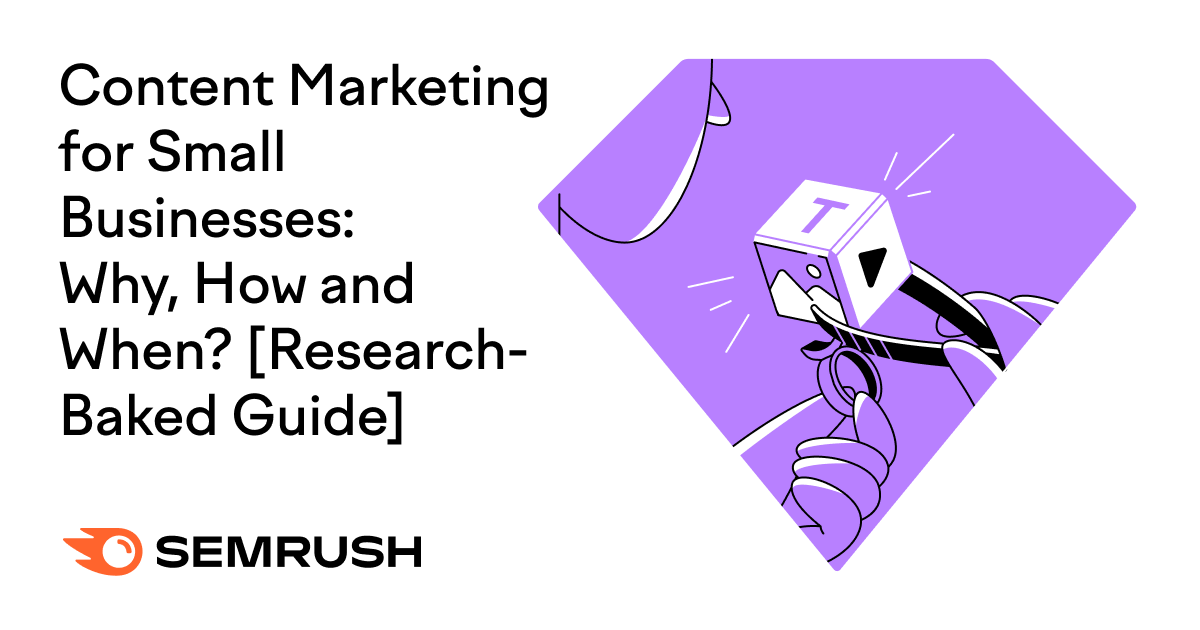Content marketing might seem like an ambitious strategy for a small business. But the numbers tell us it really is effective, no matter the size of your organization.
In this guide, we’ll hear from various content marketing experts working with small businesses. We’ll also take a look at how to create and distribute effective content—based on research-baked data and insights. Let’s dive right in!
What Is Content Marketing?
Content marketing uses blogs, social media, infographics, videos, downloadables and other engaging content to catch the interest of your target audience, as well as to engage, delight, convert and retain customers. It’s all about delivering value beyond your product offering.
Ultimately, it is a method of marketing that aims to generate repeat organic visitors to your website. It helps you capture relevant leads and grow your business.
Does Your Small Business Need Content Marketing?
We analyzed results from the State of Content Marketing Global Report, focusing solely on responses from leaders in companies between 11 and 250 employees. We found that 60% of these respondents had a “fairly developed or advanced content marketing strategy.” And it seems to be paying dividends for them: 95% claim that they are enjoying some degree of success.
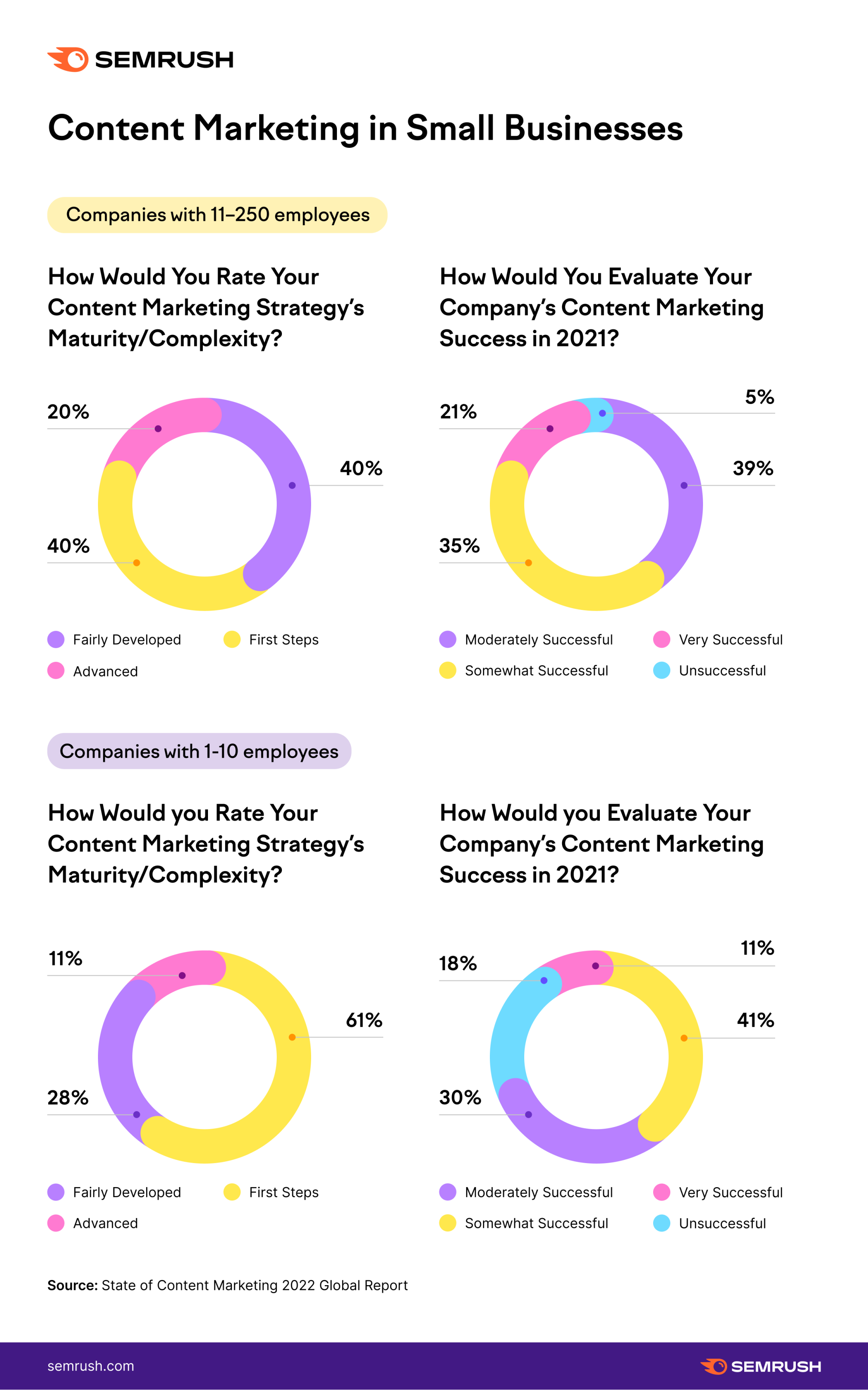
Whether your CEO or CMO has posed the question, or you are wondering it yourself, it’s important to remember that a unique brand tone of voice, quality content, and clear messaging can really help your business stand out.
Dale Bertrand, Founder and President at Fire&Spark says:
Sometimes content marketing is the best way for small business owners to compete against others with larger budgets for online advertising and PR. Be sure to leverage your unique viewpoint on your industry to get noticed.
Content is in fact one of the most sustainable online marketing tactics around.
Each piece of successful content has the potential to bring in website traffic and leads for up to 2 years—longer if it’s continually updated. This brings marketers more long-term benefits than ads, which stop attracting leads as soon as you turn them off.
On top of this—and somewhat counterintuitively—it’s not just online business that can benefit from content marketing.
Offline businesses, too, can see the return on investment. Our research found out approximately 95% of respondents in offline businesses have some degree of success with content marketing—with nearly 30% saying their content marketing efforts were “very successful.”
Benefits of Content Marketing for Small Business
Besides fuelling your marketing efforts, there are a number of clear benefits of content marketing for small businesses. Here’s how they break down.
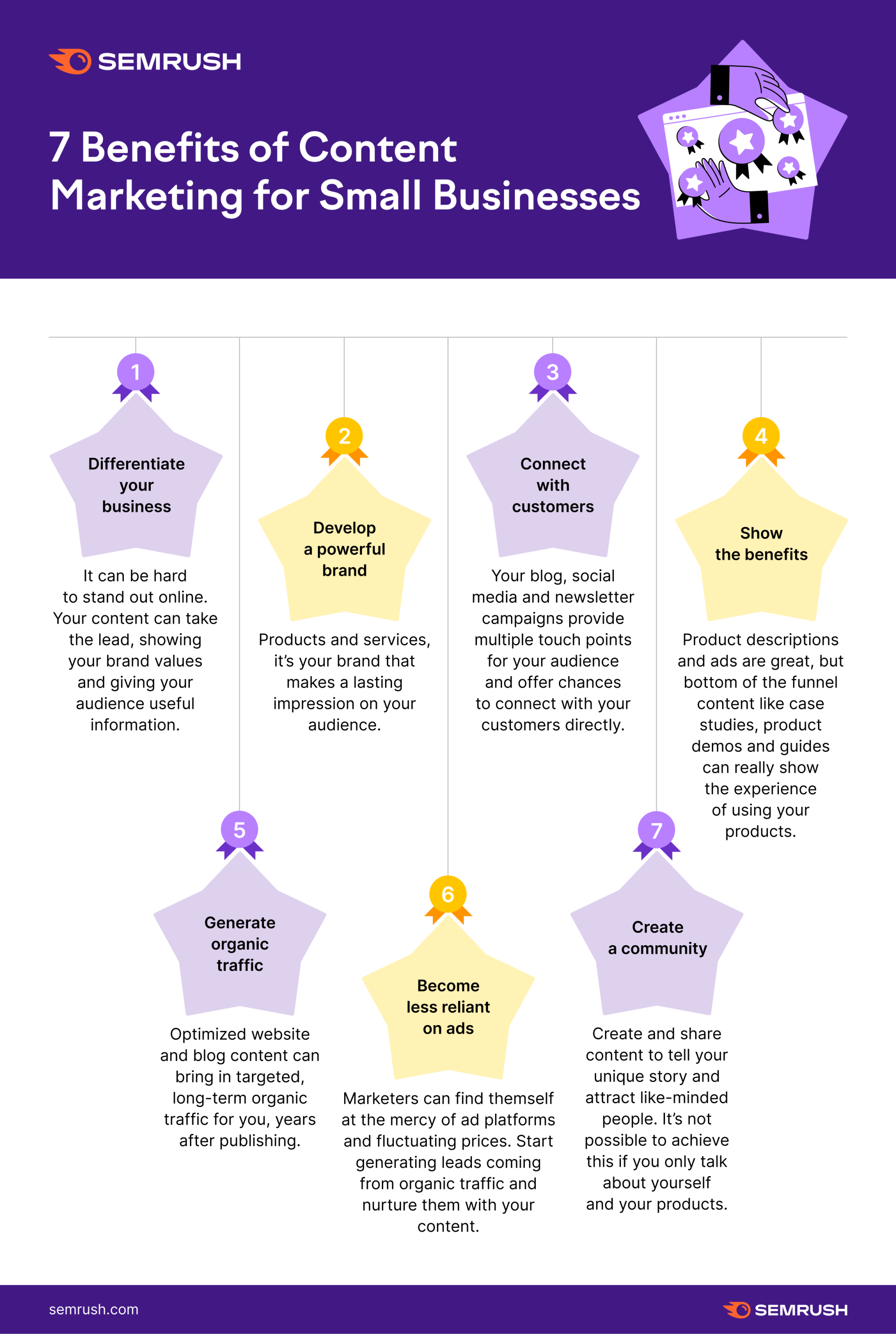
- Differentiate your business:
It can be hard to stand out online. But your content can take the lead, showing your brand values and giving your audience useful information.
- Develop a brand:
Whether you’re providing a product or a service, it’s your brand that makes a lasting impression on your audience. With a strong social and organic presence, you can get people talking about you.
- Connect with customers:
Your blog, social media and newsletter campaigns provide multiple touch points for your audience, and offer more opportunities to connect with your customers directly.
- Show the benefits of your product:
Product descriptions and ads are great, but bottom-of-the-funnel content like case studies, product demos and guides can really show the benefits of using your products.
- Attract organic website visitors:
Optimized website and blog content can bring in targeted, long-term organic traffic for years after publishing. Marketers can find themself at the mercy of social media ad platforms and fluctuating prices. Get longer-term value from high-performing SEO content and become less reliant on ads.
- Create a community:
Comments, likes and shares on social media posts tap into your audience’s network. Grow your following, increase engagement and see more traffic come your way.
When and How Should Small Businesses Start with Content Marketing?
Dale Bertrand says:
Start yesterday! The slow and steady approach works for content marketing as long as you are adding value and servicing your customers with your content. So start now and build a library of content that attracts organic traffic.
Dale makes a good point: It’s never too early and never too late to start content marketing. In fact, if you are just about to create your company, it’s a good idea to start right away or even before you start operating. Building your reputation as a thought leader is a great way to create buzz and enter the industry.
If your company has just started operating on the market, check out this guide on startup content marketing.
Pratik Dholakiya, Founder of Growfusely, says:
We have worked with quite a few SaaS brands (small businesses) to help them with their content marketing efforts, and what’s worked for most of them is consistency in their content marketing plan and execution. Even if the campaign is planned at a small scale, they should focus on consistency and the rest can be planned based on their goals and objectives. From what we’ve experienced, content marketing definitely works for small businesses if they keep long-term goals and consistency at the forefront.
What Are the Key Questions to Ask Before Engaging in Content Marketing?
Content will probably form the backbone of your marketing activities. After all, even ads need content!
But that doesn’t mean that everybody should blog or run a YouTube channel—it won’t make sense for every product or service.
Marketers and small business owners should therefore ask themselves three core questions:
- What is my key expertise?
- How can I make each piece of content interesting for my target audience?
- On which channels will this content be most effective?
Starting Out With Social Media Content
In some cases, social media content and some email marketing content could be enough to start out with. Here’s what you need to do:
Build Trust and Engage Your Audience
The key is to find a way to showcase your expertise and build trust. This is impossible if you are exclusively talking about yourself and your product, however.
Brian Moran, Founder and CEO at SmallBusinessEdge says:
Small business owners can capture the attention of their target audience by telling good stories through content marketing. You can use your mission and their unique backgrounds to fuel these stories.
Open Up and Share Your Experiences
Brian also suggests opening up and letting your customers know about what the last two years have been like for you and your business. “How did you survive? What were the silver linings?” he asks. “The more you share, the more they can connect with you”.
Balancing Long and Short-Term Goals
Regardless of when you start, you’ll need to set goals for your marketing team. Ambition is good, but you can’t expect to start ranking at #1 in the search engine results pages overnight.
Small businesses have a number of different uses for content marketing.
The biggest is to create brand awareness (46% of responses included this answer), that’s followed by boosting website traffic (41%) and improving sales results (40%).

As you can see, content can help you achieve a variety of useful business objectives.
Here’s How to Balance Your Short and Long-Term Goals
- Think about what you want to achieve
It’s important to think about the short-term and long-term gains you hope to achieve with content and plan accordingly.
How
Your goals should be rooted in business outcomes. Perhaps you want more leads, more sales, or more referrals. Consider how content can help you achieve this (for example, a downloadable guide might help you grow a mailing list).
- Break down your goals
Do not try to do everything all at once. Smaller goals are more manageable and realistic.
How
For example, rather than just having a goal to launch your Instagram channel and increase your client base, you could break your goals down like this:
Goal one
- Set up an account by the end of the week
- Add logo and brand description with a link to the shop
Goal two
- Work with a designer to decide on the look and feel of the content
- Test content types to see what gets the most engagement
- Create a four week batch of content for testing by the end of the month
Goal three
- Reach our target of 1,000 followers by the end of the second month
- Get engagement and messages from our followers
- Showcase products in stories or reels to get 10% more traffic to our website
- Set a timeline
Break down your goals into short, medium and long-term. Here are some examples of how other small businesses do this:

Remember that content marketing takes time and effort. So, do not get discouraged if you don’t see immediate results. Instead, focus on making your effort consistent and creating a sustainable model for attracting customers organically.
Keeping Your Eye on the Competition
It’s important to explore what others do in your sector. That includes both competitors and potential collaborators (e.g., influencers and bloggers in your niche).
Brian Moran says:
“Follow people who are in your ecosystem and read what they write, listen to their podcasts, and watch their YouTube videos.”
The competitive content analysis can be a great starting point helping you to understand what’s trending in your industry, what works well, and what doesn’t.
Use this free Competitive Content Analysis Template for step-by-step instructions.
Content Marketing Tips for Small Businesses
If you’re excited about jumping into the world of content marketing, but still feeling slightly overwhelmed, we’ve spoken with a few content experts and put together a number of tips. Here is what they have to say:
1. Work on your foundations
Content marketing has compounding value—and the sooner you start, the faster you will see results.
But to make sure content marketing works for you, you’ll need to have all the assets and resources ready in place.
That includes:
- Your website—optimized for users and search engines
- Design and copywriting capabilities
- Follow-up and conversion strategies like email marketing for downloadable content and calls to action in your blog posts.
- You should also have an analytics platform set up (e.g., event tracking in Google Analytics), to help you analyze your progress.
Sophie Joelle, Senior Content LeadSenior Content Lead at Flaunt Digital, says:
Focus on creating a highly optimized homepage and your key category page copy, using supporting editorial content such as blogs and guides as an internal linking opportunity. For small businesses, knowing your unique selling proposition and having a strong brand tone of voice will help to differentiate you from the competition, with keyword optimization providing the technical back-up your business needs to grow.
See which content marketing tactics worked best for other small businesses in the table below.
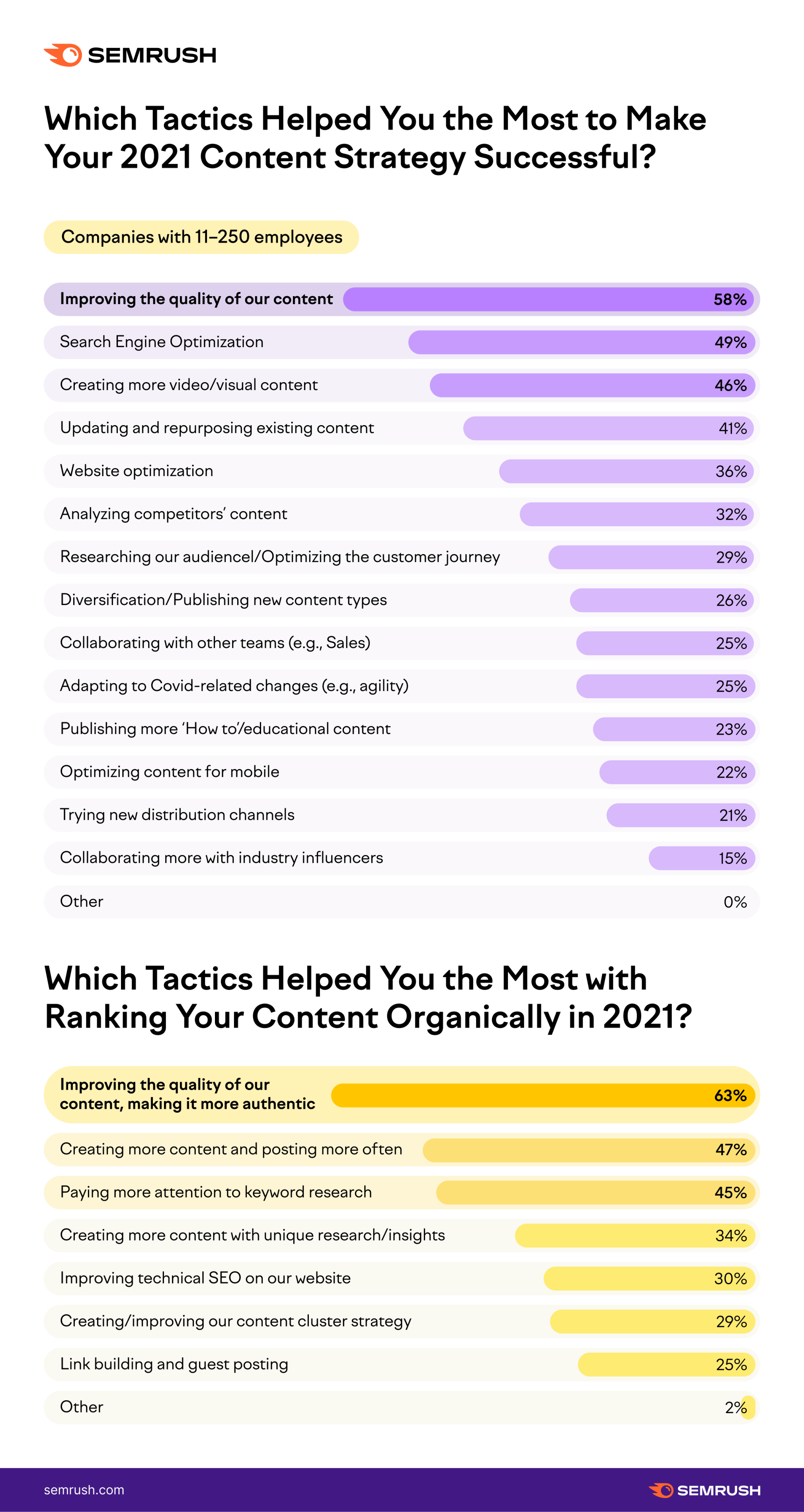
Better content, search engine optimization as well as creating more visual and video content were top answers. These were all highly successful ways of improving the overall effectiveness of respondents’ content marketing campaigns.
2. Document your strategy and plan
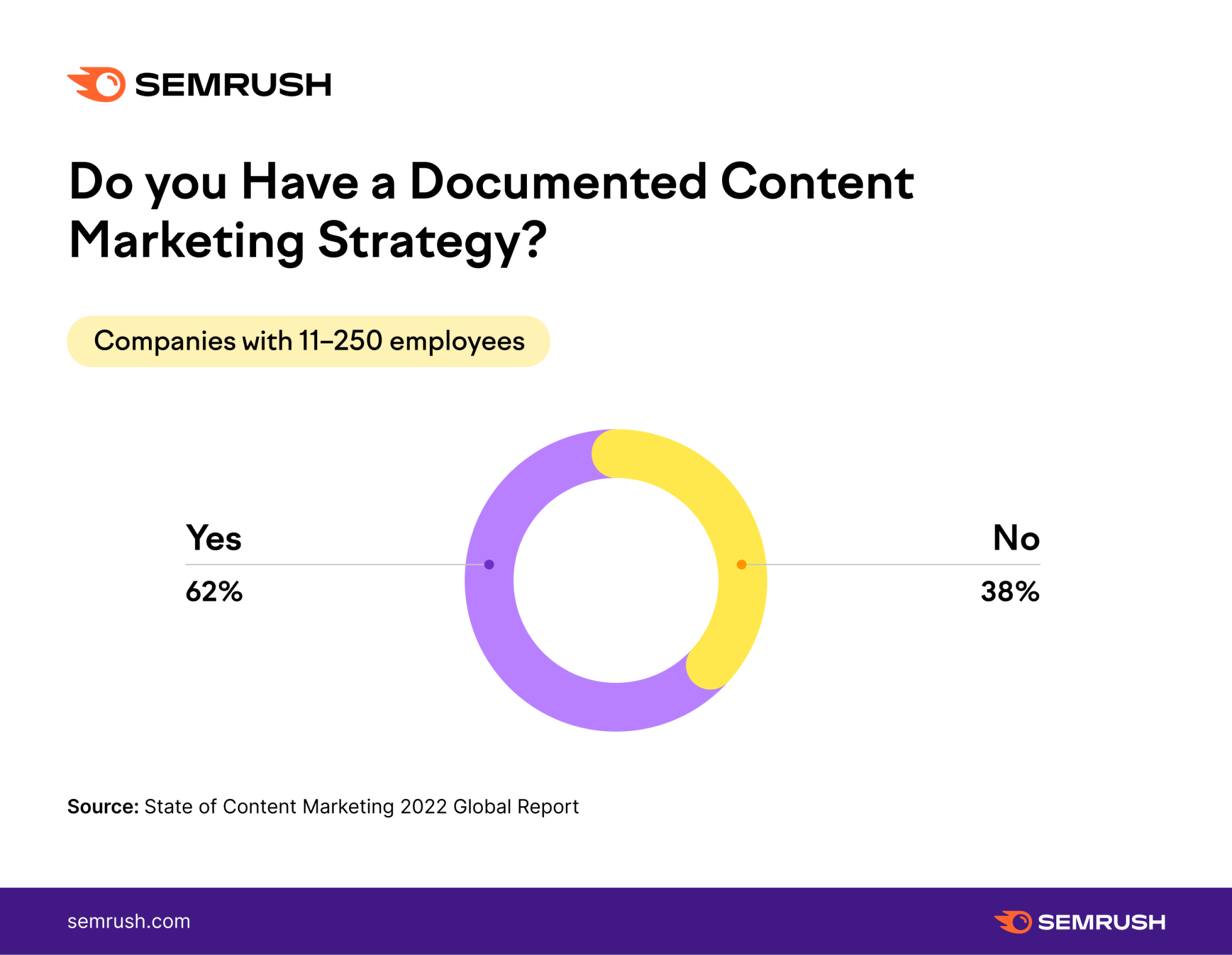
It’s never too early for building a content marketing strategy. Instead of taking a scattergun approach and chaotically creating a lot of content with zero results, it’s smarter to be strategic from day one.
Before jumping to writing blog posts and filming tik-toks, define and document the primary elements of your strategy:

A documented Content Marketing Strategy will help you be more successful. In fact, 78% of successful content managers in companies of all sizes had a documented strategy in 2021.
Check out our ultimate content strategy guide to get step-by-step instructions for this step.
3. Tell stories for impact
Brand storytelling helps you translate your company mission, background and its unique identity using narrative structures. Stories are the perfect medium to connect with your audience in terms that they understand. They also help you engage people with emotion and tend to present information in a more memorable way.
Haley Hite, Marketing Manager at Aha Media Group says:
Facts tell, stories sell. Use narrative to bring the benefits of your products or services to life. No matter what type of content you’re creating, use stories to provide proof of the quality of your offerings without sounding salesy. In the long run, this will build trust and humanize your business.
Gail Gardner, BizSugar Community Manager, adds:
“Major attention goes to those who create crazy videos. Check out the Rhett & Link commercials on YouTube as examples of videos that border on the insane. Humor works, but it can be tricky to get it just right. A safer, but equally effective way to go is story-telling. Who doesn’t like a good story, right?”
To map out your story, focus on what makes you and your company stand out, and the way you hope to change the world with your offerings and your content.
For step-by-step instructions on how to document your brand story, use this free Brand Storytelling Template.

4. Organize your content production process
Next, it’s important to organize your processes before rushing into content creation. Think about the following:
- Your resources and budget
These will determine how much content you can produce and on what timeline. Without this information, your planning efforts might be in vain.
The majority (64%) of small businesses in our survey have a monthly budget of under $1000. Only 5% are spending more than $5000 a month on their content budgets.

Here are more details on how small businesses approach defining their content marketing budgets:
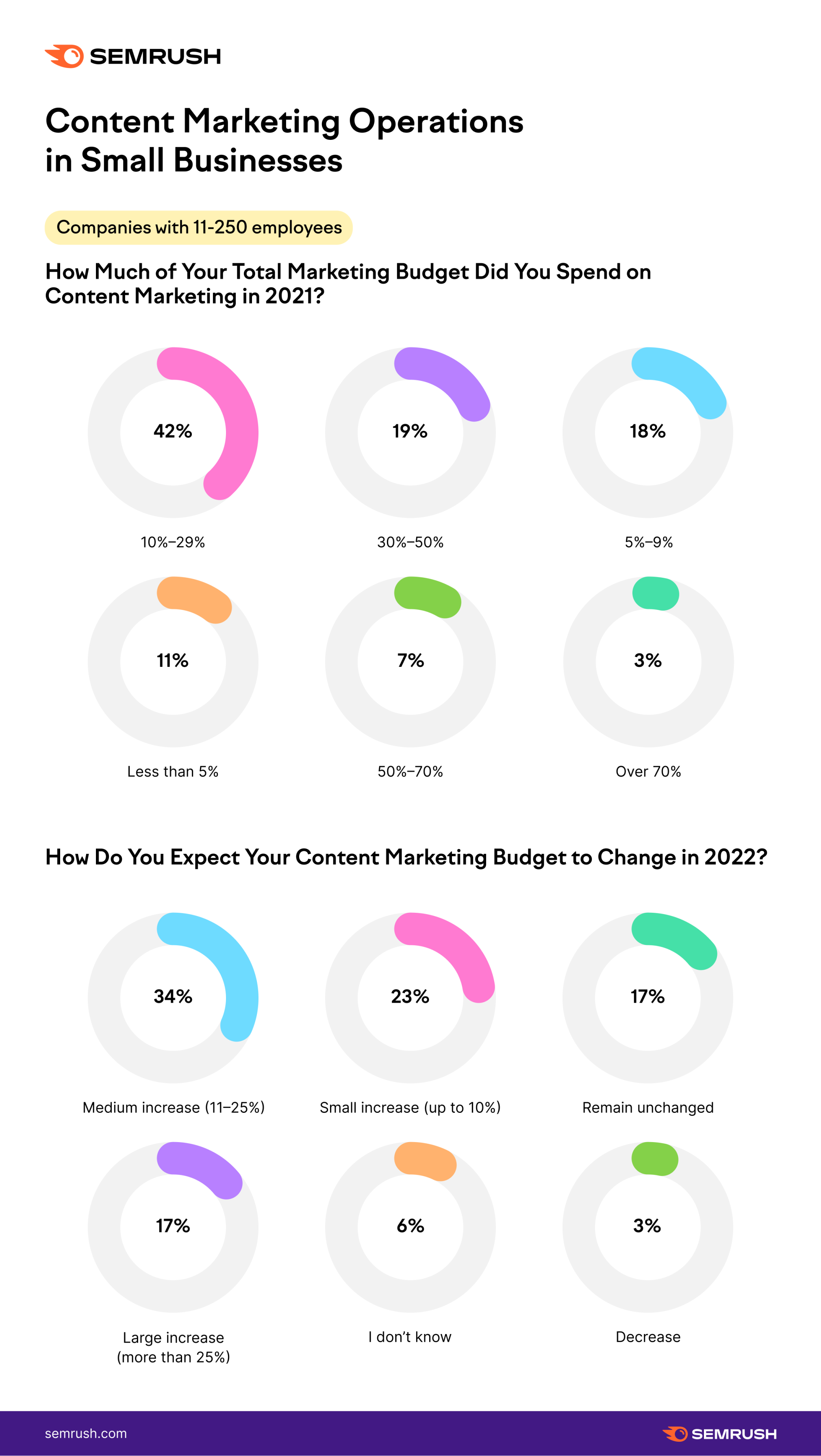
The resources you might need for content creation include:
- Human resources: content startegy and management, copywriting, design, social media management and video production
- Content marketing tools: tools for SEO, content planning, content writing and a Content Management System (CMS). If you are currently deciding which CMS to use, check out our comparison guide on WordPress vs. Wix.
The most popular technologies used by small businesses include social media posting, website analytics, email marketing, writing/editing and SEO tools:

- Who will create content
Content creation is time-consuming and often highly skilled. It’s important to consider whether you can take this on in-house, or whether you should outsource to freelancers or an agency.

Another survey we have recently conducted has found that more than 50% of businesses use internal subject matter experts (SMEs) to help them write content. A further 44% have internal subject matter experts guide copywriters as they produce the content.
For small businesses in particular, the first option can often be the most cost-effective and scalable. At the same time, this expert content provides value to the audience and helps you become a thought leader in your niche.
The subject matter experts (SMEs) in your company could be anyone from the product managers to sales and CMS folks. Think about your employees who have experience in your field and encourage them to share their thoughts. It’s also a good idea to work with external experts and influencers to add value to your content and reach new audiences.
Next, you can use those insights to create content with your internal or outsourced writers.
Your content should answer your customers’ most pressing questions and make sure it’s opinionated. If you demonstrate your unique point of view on your products or service/industry then you will find like-minded influencers, organizations or trade groups who will help you promote your content.
- How to organize your content calendar
You need a clear strategy for achieving your business goals. A comprehensive content calendar is essential.
Joseph Saunders, Content Writer at INFUSEmedia, says:
Your plan should also cover publishing cadences (frequency, time of day, and day of the week), the channels you want to publish across, and finally, the supporting promotion you want to run to boost your content’s reach.
He suggests analyzing content performance to ensure you’re on the right track. “Building a solid foundation with a content marketing plan will allow you to create a launchpad for experimentation and optimization that will lead to further success and competitive positioning,” he adds.
Your content calendar will include the following items:
- Content topics and keywords
- Content formats
- Related audience
- Timeline
- Teams and employees involved
- Content funnel stage
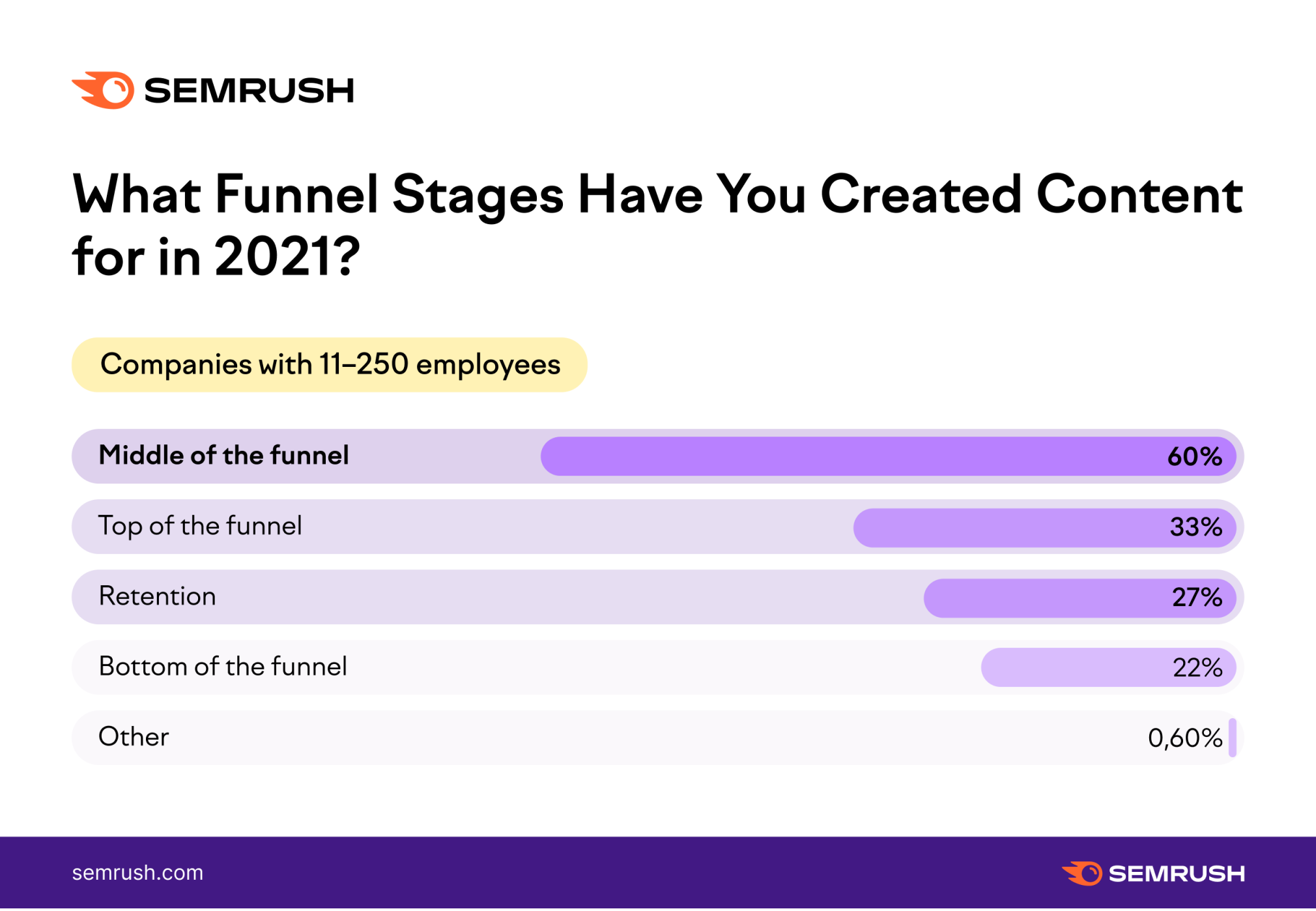
For step-by-step guidance on how to build a content calendar, download our free Content Calendar Template.
5. Put customers first
It’s important to think about targeting topics that will resonate with your target audience and make sense for your business goals.
Dale Bertrand says:
The key is to craft targeted content for a niche customer base and develop valuable content that helps them make a buying decision. Ask yourself if your content is adding anything new that will help your customers make a buying decision or if your content is similar to what’s already been published by other businesses.
Michelle Buck, Marketing Coordinator at Crystal D, says to think through content ideas and opportunities and make sure it is something your customer can gain value from:
“Does it solve a problem? Is it helping them through a pain point? We can do a lot of things as marketers, but we will wear ourselves out! Be intentional about your marketing plans and build a strategy around it with the focus on your customer.”
How can you do this?
First things first, you should always rely on extensive audience research and data when making content marketing decisions. It’s key to shift your perspective when deciding what to create and evaluating the content that has already been produced.
Try putting yourself in your customer’s shoes and asking yourself whether your content is:
- Relevant
- Practical and actionable
- Enjoyable to explore and easy to understand
There are some tools that can help you add automation to this process. For example, the Topic Research tool can help you align your content plan with your audience’s interests and bring in targeted traffic to your website.
First, simply type in a basic idea that relates to your business or your buyers, in the location you are targeting. This could also be a high-volume keyword.
In the example below, we’ve chosen ecommerce, with a U.S. based audience:

Next, you’ll see a whole range of connected ideas.

If one strikes you as interesting—perhaps it has a high volume of searches, or seems very relevant to your audience—click to expand.
You’ll be presented with Headlines from existing articles on this topic. You can click on these to be taken to the connected blog. Also explore common questions, which can be filtered into what, why, is and how questions.

If you’re still exploring, you can dig in further to find related searches.

You might also like to see the data presented in different ways. Simply click on the different filters, Cards, Explorer, Overview or Mind Map to do so.

Case Study: The Topic Research Tool in Action
The Barbauld Agency used Topic Research to generate content ideas that helped their client increase organic traffic by 133%
In one case, they used the tool to find an idea for one of the most successful blog posts—a guide to correctly placing letterman jacket patches and pins.
This post now ranks #1 in search. They discovered the idea by tying in the “chenille patches” keyword and exploring related questions.

6. Be Experimental
Don’t be afraid to shout your brand from the rooftops. On this front, Sandip Acharyya, Founder of MarTech Sprout, offers some key tips, explaining that as a small business:
1. You are small, so you have limited reach
2. The content topic/subject you are using is already covered by “bigger” companies.
If you write generic content, it is unlikely to cause even a ripple in the vast ocean of content already published. There is already an information overload & content fatigue in the industry.
Sandip goes on to say:
- Be bold and experimental. Use anything that sets you apart. You can use memes, satire, pop culture comparisons to attract your audience. They provide a much-needed break among those well-tailored blogs currently on the internet.
- Share your opinion. Your audience already knows “the best strategies” or “10 trends to follow” in your domain. Rather than following the herd, share your opinions. Tell your audience where you stand on the topic.
- Be visually attractive. A unique headline, a colorful cover image, and the use of other elements like smileys can make quite a difference.
7. Diversify Content that Works
Got content that’s crushing your KPIs? You rock. It’s time to diversify it to suit your target channels.
That means to take your high-performing content and repurpose it for different mediums—so you can connect with customers in lots of different places.
For example, a blog can become a series of Instagram stories, a report can become a webinar, and survey results can be turned into an infographic.

Anastasia Chechkova, Growth Analyst at OnePageCRM, says:
“As a small business, you don’t have as many resources as large companies do so you need to make the most of each piece of content. Repurpose your content: This means that you can get a high engagement or reach without creating brand-new content. In other words—when it comes to content marketing in a small business—do things that scale.”
Katarina (Nina) White, Content manager at Optiliy, agrees saying
Small businesses with a solid distribution strategy can thrive on many channels in various formats, even with a small team.
Examples of Content Marketing Ideas for Small Businesses
Beyond writing great blog posts there are many content types to consider. Here are some top content marketing ideas for small businesses:
- Podcasts: Top-performing blog content can easily become the topic for an interview or deep dive on a podcast. At the same time, you’ll develop relationships with industry players, lift the “corporate veil” and share opinions, information and advice with your listeners. More to the point, podcasts are popular: 41% of Americans listen to podcasts monthly.
Podcasts can be free or very cheap to produce. Simply invite people from your own company and record it on a basic Zoom, using a microphone to improve audio quality.
Check out The Yogi Show, a podcast by Pedro and Bryan, two Yoga Instructors who have taken podcasting to the next level and also have a popular Instagram account.

- Videos: Grab your target audience’s attention with videos on any number of platforms, including Instagram, Tik Tok and YouTube, amongst others. Videos offer a great way to personify your brand and build trust with your viewers.
Explore the SquareSpace’s “All you need to Launch…” series for inspiration!
As a small business, you can still create videos on a budget. Enlist your team to help create short Instagram and Tik Tok videos.
Check out ThinkGeek for a great example. It’s a small ecommerce business that has grown to over 214,000 subscribers on YouTube. It sells “geeky” items for sci-fi, fantasy and gaming super fans.

- Blogs: Articles are a great way to drive organic traffic to your web. Once you’ve got a range of topic ideas and have done keyword research, you’ll be ready to produce content tat people are really interested in and searching for.
Egoditor is a small business that did just that, getting over 20,000 visits per month after just six months of blogging. To do this, the company used the Topic Research tool to gather hundreds of ideas and used the Semrush Writing Assistant to optimize their posts.

- Newsletters: Sending content straight to a subscriber’s email could be an effective means of connecting with your audience. In fact, we’ve found e-mail to be the best performing content types for small businesses. Share snippets of your best content and get more eyes on your best performers.
For inspiration and some great food content, check out pastry chef and recipe developer Nicola Lamb’s newsletter—Kitchen Projects. It often gets cited as one of the best food newsletters around. She goes into great detail, including her reasoning behind the recipe development process.

8. Be selective with your content distribution channels
Don’t boil the ocean. It’s easy to try and create content everywhere—but it’s not necessary. Focus on where your most valued customers are in the sales funnel. Then, build your content slowly.
Nicole Wolfe Content Strategy Manager at TopSpot Internet Marketing, says it’s important to choose your channels carefully, too:
Are your customers on social media? Do they watch videos, and if so, where? Do they look at photo galleries, specs, or other data? Once you have identified the best outlets for your customers, creating content that can be repurposed is an efficient way to generate more with less.
Once you’ve created incredible value for your audience, it’s time to think about sharing your content.
Sharon Glenn, Digital Content Manager at Toyota North America, says:
“Learn where your audience is and what they are looking at, and that will help you find a distribution strategy to bring relevant content to their doorsteps. Consider a mix of social media strategies, thought leadership, events, paid search, and influencers to help drive your message to your audience.”
Where Do Small Businesses Distribute Their Content?
According to our research, most small businesses (70%) say they distribute over social media (organic), email channels (59%), and paid social (53%). Many also engage in search engine optimization (organic search: 42%) and sponsorships, including events, webinars and podcasts.
Others also focus on PR, pay-per click, influencer marketing, content syndication, among other distribution channels. 39% of small companies are also planning to increase their paid content marketing budgets.
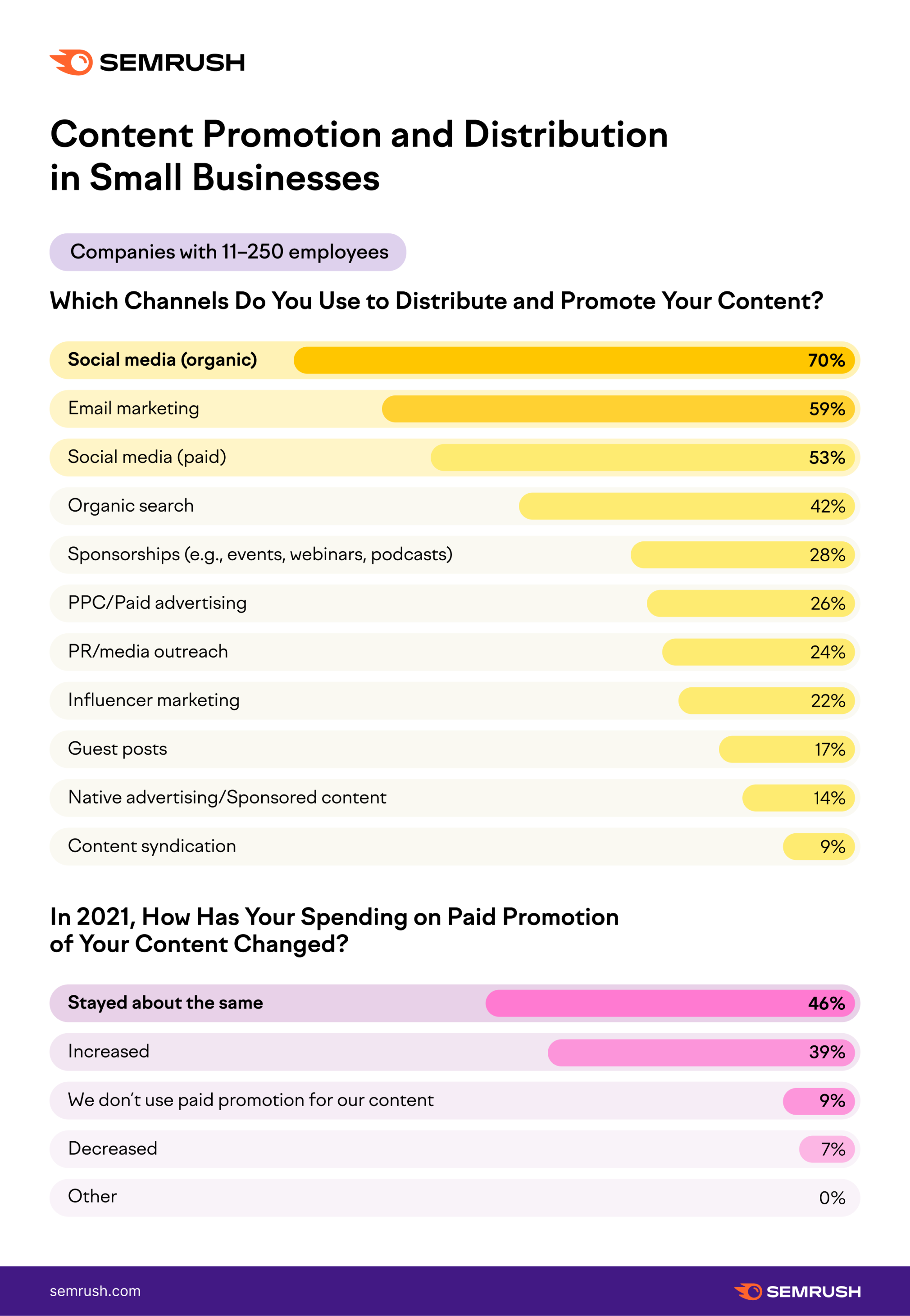
9. Keep an Eye on Your Metrics
Finally, it’s essential to track your success against the goals and KPIs you’ve set for your content marketing efforts.
You can use analytics platforms like Google Analytics to see what’s working (and what’s not) and keep iterating to make it better.
Tools like Semrush’s Position Tracking and Content Audit will also help you monitor your ranking and evaluate the effectiveness of your content.
Some top metrics to track are:

Explore other key metrics for your continent in our blog on Content Marketing Metrics.
For more information on how to optimize your content, check out our in-depth guide: The Art of Content Optimization.
Final Thoughts
With over 97% of businesses including content in their marketing strategy, it’s time for your company to jump on this trend and build a foundation for attracting customers organically. Be sure to focus on providing valuable and high-quality content and document your strategy.
To make your efforts more organized and data-driven, try the Semrush Content Marketing Platform. It will help you improve your online visibility, reach new customers, and grow your business with content.

